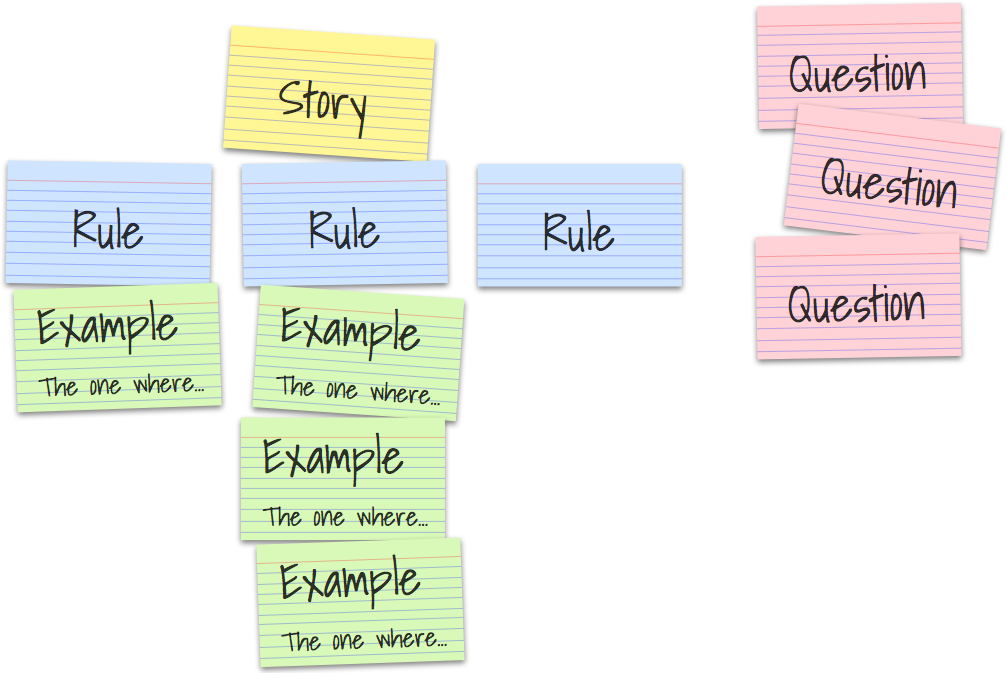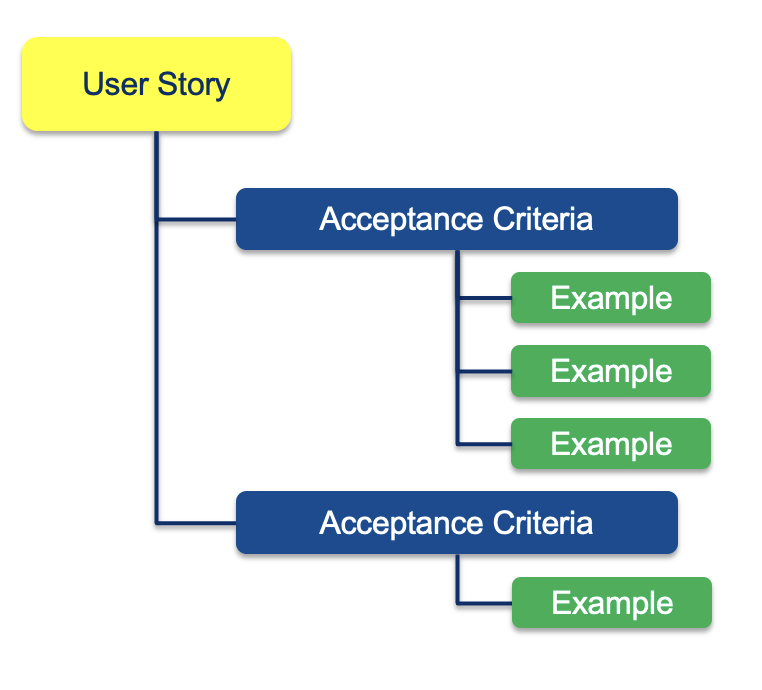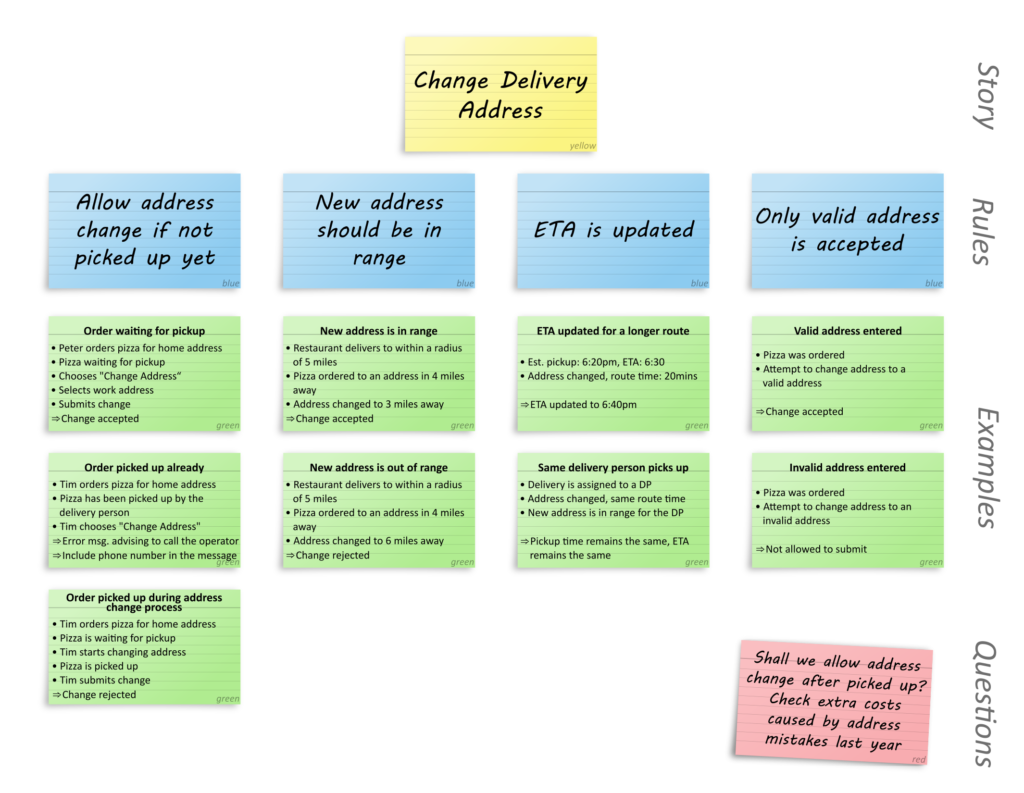Example Mapping
Example mapping is a technique for gaining clarity around the acceptance criteria for a given User Story. It is based on the idea that multiple examples of specific cases convey information better than a single bad abstraction of a concept.
Why?
Example mapping should be used with the right people in the room to be able to explain:
- Business rules
- Example scenarios
You need to have business experts and technical knowledge people that can ask the right questions about those rules.
It should be used as a tool to ensure that the team appropriately understands what is expected of the story, and to get the stakeholders involved in the development of acceptance criteria.
Problems
- How to build a shared understanding on functionalities?
- How to avoid misunderstandings, incorrect assumptions when developing new functionalities?
How to
- Business experts (PO or BA) present the problem to solve
- To illustrate the feature : walks through a couple of concrete examples
- Explains why a user might want this feature, and what it allows users to do that they couldn't do previously.
- Lists the key business rules and constraints that he/she knows about
- Others build their understanding together by asking questions about :
- The examples :
what if...,what else... - The business rules :
so that means...
- The examples :
Developer(s) will be thinking of technical constraints and possible solutions.
Tester(s) will be thinking of edge cases and testability concerns.
Run an example mapping workshop
- Start by writing the User Story being discussed on a
yellowpost-it note and placing it at the top of the table. - Then we write each of the acceptance criteria, or rules we already know, on a
bluepost-it and place them under the yellow post-it of the User Story. - For each rule, we may need one or more examples to illustrate it. Write them on a
greenpost-it note and place them under the relevant rule. - When discussing these examples, you may discover questions that no one in the room can answer.
- These are written on a
redpost-it and the conversation continues.
- These are written on a

We continue until the group is convinced that the scope of the User Story is clear, or we run out of time.
Facilitation tips
- To avoid influencing and biasing each others it is highly recommended to let each participant think about the questions he/she would like to ask in his/her corner. This leads to richer discussions and make the place safer to run this workshop.
- Capture the Ubiquitous Language.
- During the session, discussions may occur on given words : it is the perfect time to enrich your Ubiquitous language
- Capture those words in your favorite tool and agree on their definitions
Outcomes
- New User Stories / split
- Refined rules / acceptance criteria
- Key examples
- Shared understanding

Gherkin syntax
Just like with acceptance criteria we can use Gherkin syntax to describe clearly our examples :
Given <context> // Setup the context (can have multiple lines separated with AND)
When <action> // Perform an action on our system
Then <expectations> // What are the expectations

An example
Feature: Score Calculation
In order to know my performance
As a player
I want the system to calculate my total score
Scenario: Gutter / Children game
Given a new bowling game
When all of my balls are landing in the gutter
Then my total score should be 0
Scenario: Beginners game
Given a new bowling game
When I roll 2 and 7
And I roll 3 and 4
And I roll 8 times 1 and 1
Then my total score should be 32
Scenario: Another beginners game
Given a new bowling game
When I roll the following series: 2,7,3,4,1,1,5,1,1,1,1,1,1,1,1,1,1,1,5,1
Then my total score should be 40
Scenario: All Strikes
Given a new bowling game
When all of my rolls are strikes
Then my total score should be 300
Scenario: One single spare
Given a new bowling game
When I roll the following series: 2,8,1,1,1,1,1,1,1,1,1,1,1,1,1,1,1,1,1,1
Then my total score should be 29
Scenario: All spares
Given a new bowling game
When I roll 10 times 1 and 9
And I roll 1
Constraint
Stop writing code, in group challenge the current User Story / Feature you are working using this format
- Individually, write down your questions - 5'
- Answer the questions together
- Describe some examples together